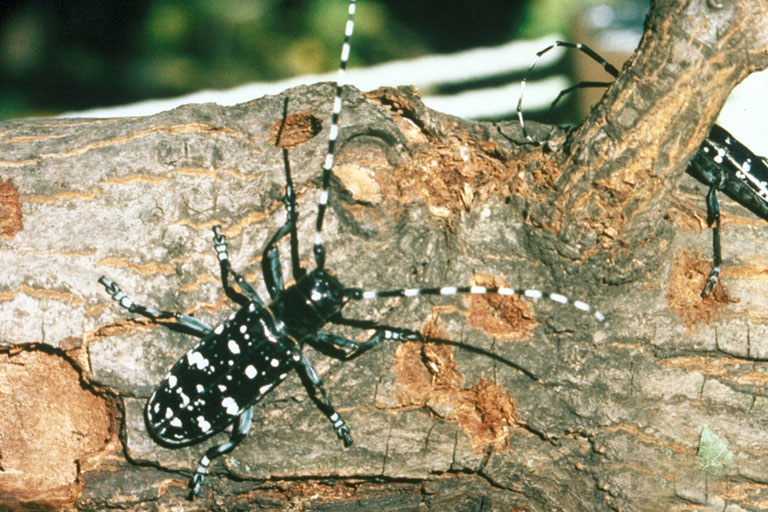Scientific names: Citrus Longhorned Beetle (Anoplophora chinensis), Asian Longhorned Beetle (Anoplophora glabripennis), and Red-necked Longhorned Beetle (Aromia bungii)
What Are They?
Citrus (Anoplophora chinenses), Asian (Anoplophora glabripennis), and red-necked (Aromia bungii) longhorned beetles are large beetles whose larvae feed on and in the wood of trees. When the beetles mature to adulthood, they emerge through holes that weaken the trees further. They are extremely destructive to hardwood trees.
Are They Here Yet?
No. All three species were found in Washington warehouses or nurseries at least once in isolated incidents. The beetles came in with foreign nursery stock, which at the time was not regulated for these particular pests. With the increase of global trade and movement of plants via the internet, the state still is at risk for new introductions of all these species.
Why Should I Care?
Unlike native longhorned beetles that typically feed on dying trees, invasive long-horned beetles can attack more than forty species of healthy trees, sometimes killing them. Letting these establish in Washington would be devastating to forests, parks, and yards.
What Are Their Characteristics?
Citrus Longhorned Beetle
- Similar in appearance to the Asian longhorned beetle described below, it is large, stout, and about 1 to 1 1/2 inches long with shiny black wings marked with 10 to 12 white round dots.
- The male is generally smaller than the female, and the wings entirely cover their abdomen tip. The female’s abdomen is partially exposed.
- The male’s antennae are longer than the female’s in comparison to their body size.
Asian Longhorned Beetle
- Large, robust beetle, glossy black with irregular splotches of white on the wings.
- The antennae are striking with black and gray bands.
- The feet and legs are decorated with a slate blue hairs.
Red-necked Longhorned Beetle
- 4/5-1 1/2 inches long with a body that is almost entirely glossy black except for a red thorax, between its head and abdomen
- The female’s antennae are as long as its body, while the male’s antennae are about 1 1/2 times as long.
How Do I Distinguish Them From Native Species?
The Asian and citrus longhorned beetles have a few native lookalikes, including the banded alder borer (Rosalia funebris) and several species in the genus Monochamus. Monochamus species have smaller white spots, small white triangles on their upper backs, and visibly rougher, bumpier, and less glossy exoskeletons. Please visit these links to help with identification:
- Iowa State University’s BugGuide: Banded alder borer, spotted pine sawyer, and Oregon fir sawyer/ Whitespotted sawyer
- Washington State University Extension
- University of Vermont
How Do We Stop It?
Because these beetles feed on wood, the most important prevention measure is limiting the movement of firewood. In other words, Buy it Where you Burn it.
Native Look-a-Likes


Additional Photographs




